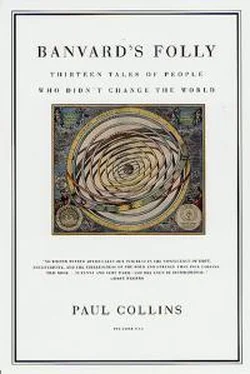When the second edition of Pleasonton's book came out in 1877, claiming that cobalt glass could cure everything from gout and spinal meningitis to paralysis and pulmonary hemorrhages, blue light had become a genuine craze.
Homeowners were adding sunrooms onto their homes set with blue glass; decorators were snowed under with requests for blue curtains and blue wallpaper. Fashionable health spas in New York City had to scramble to get contractors and glaziers in: not only were patrons demanding sunrooms, they wanted them to be made entirely of blue glass. It was a bonanza for overnight schemes like the Mazarine Blue Glass Company, which sprouted up at 823
Broadway advertising "Imported Blue Glass, Arranged in Frames, Scientifically Constructed According to the Beidler Patent."
H. Mercer Beidler was one of many fellow Philadelphians who had cashed in on Pleasonton's discovery. He'd attempted to patent a striped blue glass pane design, which was then to be "scientifically" set at a fifty-six-degree angle over the user's body. Portable models were available for travelers to use on the decks of ships. Beidler had published his own pamphlet and built a public blue glass parlor at the corner of Ninth and Chesnut, with "Hours for Invalids 10 A.m. to 3 P.m."
Some would-be customers, as a subsequent notice by Beidler in a local paper showed, were not entirely clear on the concept:
We are sorry to disappoint the good people who crowded our parlours all day yesterday, hoping to avail themselves of the first opportunity to enjoy our vitalizing and life-giving Blue Glass Sun Baths; but they will please remember
in the future that the Baths can only be administered when the Earth is bathed in the bright sunshine of heaven.
But on sunny days, at least, the invalid and the merely languid alike now spent their afternoons lounging in a blue haze. "It is now quite common along our streets and avenues," observed Scientific American in April 1877, "to see frames of azure crystals hanging within dwelling house windows; while, on sunny days, the invalid grandfather or other patient, may be noticed basking in the ethereal rays, his countenance filled with hope, though streaked with blue."
Blue light quickly jumped from America to Europe--it was Belgian factories, after all, that still supplied the world with most of its blue glass. "Blue light baths are, it appears, an infallible remedy for pains in the bones arising from rheumatism or railway collisions," The Times of London enthused.
Over in Paris, opticians frantically made a run on "medicated glass"--blue glass--because their customers didn't want the green or smoke-tinted ones anymore. One commentator hoped that this would only prove to be a temporary visual aid, since "offensive colored spectacles or goggles so disfigure the countenance and detract from the natural appearance of our Students, Lawyers, Doctors, and Clergymen."
Inevitably, blue glass began to show up in popular culture. When the American humorist Josh Billings issued his yearly collection for 1877, it was titled Josh Billings' Trump Kards: Blue Glass Philosophy--and printed, in a nod to Pleasonton's book, on blue paper. In Philadelphia, the prolific composer Edward Mack published "The Blue Glass March," complete with a cover illustration depicting invalids in a sunroom tossing their crutches aside.
Mack, as much as anyone, had a good sense of the pulse of popular culture; he'd previously had hits with novelty piano tunes that cashed in on the late 1860's craze for bicycles, "Velocipede Gallop" and "The Cyclopede Waltz."
The height of blue glass giddiness came with the publication of an entire book-length spoof: John Carboy's Blue Glass a Sure Cure for the Blues (1877).
Carboy, a pen name of humorist John Harrington, was a prolific writer for J.
B. Collin and Co., a Manhattan publisher of the cheap humor quickies that sold on railroad platforms and street corners for a quarter each in paperback.
Teamed up with his frequent collaborator Thomas Worth, a fine pen-and-ink caricaturist, Carboy gleefully leaped into the blue glass fad.
Like any good satire, Carboy's was based on a thorough knowledge of his subject: he clearly had read Pleasonton's book very carefully, and then proceeded to exalt it to ludicrous lengths. "Blue Glass isn't any of your common quack nostrums, like Jink's Solidified Bug Juice, or Doctor Scrap's Carbonated Extract of Hepisdam," he assures readers. "Blue Glass Cures Constipation of the Obituary Organs! .... Cures the Itch Without Scratching
.... As a table-sauce it has no superior, and for polishing furniture it cannot be surpassed." He then dispenses all kinds of handy household hints for the use of blue glass, such as "Square pieces of blue glass weighing six pounds each may be used for dispersing a cluster of tom cats."
At the center of Carboy's account is one "General Bottleton," who finds that a giant magnifying glass of blue glass makes criminals confess, cures drunkards, vanishes warts, and--most hilariously to Carboy's readers, I'm sure--bleaches black people white.
Carboy could also spoof the testimonial letters in Pleasonton's book with perfect pitch:
DEAR BOTTLETON,
I have been for years afflicted with an amanuensis in the verticle goiture of my left arm, followed by a paragraph of the liver, which left me in a comictoes condition, with a constant suppuration of axminster over the protoxide of my manipulative organs .... Dr. Carnochan advised me to have my umbilical cord stuffed, and diet myself upon the farinaccous extract of solidified lightning. I tried his advice; but, alas! my sufferings were in nowise abated. Then, as a last resort, I bought five sheets of Blue Glass. The first sheet brought out my sine qua non, reversed my crustacea, and expanded my cheek-bones, so that I couldn't close my mouth without lifting my shoulders with a rope and tackle. The second, however, remedied, by removing my secretions, and bringing about a general pulverization of my cardigan coagulations .... I can now get drunk every day, with no trouble ... You can publish this for the benefit of all mankind and other afflicted people.
Enriched beyond his wildest dreams by the craze for "bluefied solar rays,"
General Bottleton soon takes to jaunting about town in a magnificent blue coach, driven by a blue-eyed coachman who lays a blue whip to blue-ribboned horses wearing blue glasses.
In reality, General Pleasonton made very little money from the frenzy that he had sparked. His was an altruistic project, meant to bring the blessings of blue light to all humanity. By 1877, though, seeing quacks and doctors alike profiting off his discoveries, Pleasonton decided to enforce his 1871 patent.
He explored a partnership with the Keely Motor Company, which claimed to harness the atomic vibration of water molecules with a "hydro-pneumatic pulsating vacuum engine," a perpetual motion machine invented by founder John Keely in 1872. "The stockholders of Keely Motor," The Manufacturer and Builder magazine dryly noted, "have come to the conviction that blue glass is to be the connecting link between solar power and the machine for the perfection of which they had furnished the funds"--in other words, a sort of solar-powered atomic reactor. Not surprisingly, the Keely Motor Company failed to profit anyone much except, perhaps, John Keely.
Undeterred, Pleasonton then had inserts placed into the second edition of his book reminding readers- "Specific licenses can be procured from me, with directions for the use of my discoveries, and for the proper kinds of glass to be used." But nobody paid any attention: the blue glass trend was much bigger than Pleasonton now, and the niceties of patent law were hardly any match for the waves of customers demanding cobalt-tinted glass in every shape, size, and form. In fact, it didn't even have to be glass; his competitor Beidler was now also recommending for consumptives in blue parlors "that the body be denuded to the waist, with a cape of light flannel checked with blue and white preferred, thrown over the shoulder."
Читать дальше











